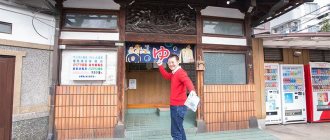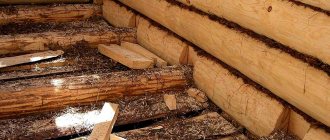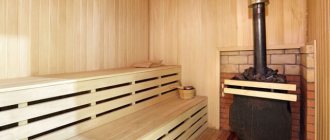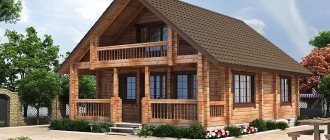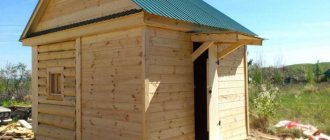Since ancient times, the Japanese bath, like any other bath, has been considered an indispensable means of caring for the skin and body, affecting the body not only hygienically, but also healingly, acting not only preventively, but also as an excellent remedy for various colds and other diseases. types of diseases. Even in Latin, the word “Bath” means “expelling illness, sadness and pain.” The Japanese bathhouse is no exception; it simply is not a specially equipped room, but a font in the form of a wooden barrel with a heater.
A Japanese bath or font, during the entire stay in it, allows a person to get rid of 0.5 to a whole liter of liquid through sweating, along with a large amount of salts and other unnecessary and harmful substances, as well as increase blood circulation and strengthen the cardiovascular system.
An ancient legend of the Japanese Dragon clan says: Unite all the elements into one, and you will become an absolute warrior.
The Japanese understood that of course it would not work to “unite all the elements into one” and “become an absolute warrior” in the literal sense, but in every fairy tale there is only a part of the fairy tale. And thanks to their ingenuity, they were able to bring the old legend to life as accurately as possible. They brought together the most important things from each of the four elements. From fire - heat, from water - moisture, from air - steam, and from earth - stability. And it turned out that a person, getting into the very center of this interaction, becomes an absolute warrior - wise, physically and spiritually strong. As you know, everything ingenious is simple, so they called this entire system in one word - ofuro , which translated means “bathhouse”. Yes, it is ofuro that combines the best of the four elements and transmits it to a person.
Perhaps the name “banya” is too rude, because it is not quite similar to the Russian bathhouse familiar to us all. In the West, many successful and wealthy people have already appreciated the advantage of ofuro over conventional saunas . What is homemade water ofuro ? This is a wooden barrel made of high-quality wood, with a stainless steel stove installed inside or outside. Equipped with benches and a grill to protect the stove from touching. The design itself does not contain anything monumental or overly complex.
Features of the furaco bath
The traditional Japanese bath complex includes 2 elements: the furako bath itself and the ofuro bath:
- Furaco is a round or oval barrel made of wood. It is better to use valuable wood, since during bathing it enriches the water with essential oils and tannins, which has a beneficial effect on health.
- Ofuro is a rectangular container or tub filled with sawdust, preferably cedar, or pebbles. This very unique addition replaces a sauna, as it provides deep heating of the body.
In its simplest form, a Japanese bathhouse is a real barrel, spacious enough to accommodate a person in a sitting position. The barrel is equipped with a pair of steps, filled with hot water, which is then drained and replaced.
Important! Furaco does not serve as a bathroom in the usual sense of the word. You need to wash with soap first - in the shower, for example, and warm up in the barrel like in a steam room, but not with steam, but with hot water.
A more complex and modern version of the Japanese bathhouse, Furako, is a large font divided into 2 unequal parts. The more spacious one is intended for the bathroom and is equipped with benches for seating. A stove is installed in the smaller part of the bathhouse. Tradition presupposes a wood-burning stove, but today Furaco is equipped with both gas and electric models.
The stove can also be located outside: this option is more convenient if the Japanese bath is small in size.
The benefits and harms of furaco
The effect of furaco on the body consists of two components. Firstly, this is the influence of heated wood, which releases essential oils and beneficial substances into the water. Secondly, this is the hot water of the bath: its temperature in a Japanese furako barrel reaches 45–50 degrees. Such a hot liquid is difficult to perceive at first, you need to get used to it.
Important! The use of hot water is explained by historical traditions. In Japan, the source of heated bath liquid is numerous thermal springs.
The Japanese furako bath, despite the unusual appearance and nature of the procedure, has the same positive effect as the usual forms of steam room and sauna:
- warming up in the bath stimulates blood circulation and accelerates metabolic processes;
- hot water opens the pores, which leads to improved skin quality and restoration of capillary blood circulation;
- uniform heating of the body normalizes the activity of the heart and blood vessels, due to the short duration of the procedure - up to 20 minutes, the Japanese furako bath does not put a strain on the heart;
- profuse sweating also activates lymphatic drainage, which helps reduce swelling and restore normal water-salt balance;
- warming up in hot water prevents numerous diseases of the musculoskeletal system and respiratory tract ailments;
- you can arrange a furaco not only in a special room or building, like a bathhouse, but even in a fairly spacious bathroom.
Important! Essential oils and tannins also stimulate metabolism and improve the functioning of the immune system.
The Japanese bath also has its disadvantages:
- for heating it is advisable to use your own heat source; a furaco stove cannot heat the room itself, much less the dressing room and washing room;
- Not everyone likes a hot water bath; fans of steam or simply high temperature will not like this option.
Comment! Furaco is made from the highest quality wood. The best barrels are made from mature planks that are 200–500 years old.
Contraindications to visiting furaco
Like any other procedures involving hot water or steam, the Japanese furake bath has contraindications. They are associated either with the general health of the user or with damage to the skin:
- acute respiratory, viral, infectious diseases, as well as exacerbations of chronic ailments, especially if they are accompanied by an increase in temperature, are a direct contraindication, you should wait until recovery;
- It is not advisable for children under three years of age to swim in such hot water;
- Pregnant women should not visit the furaco bathhouse: hot water stimulates uterine contractions, and this can lead to miscarriage, especially in the early stages;
- if you have epilepsy, tuberculosis, or hypertension, you should consult a doctor before visiting a Japanese bath;
- If there are open wounds, burns, frostbite and other skin damage, you should not take a hot tub.
Visits to the Japanese furako bath, along with visits to the sauna or steam room, are prohibited if there are contraindications associated with special conditions: for example, after surgery, when performing certain cosmetic procedures, etc.
Therapeutic effect
Nowadays, the entire population of Japan washes with soap, but the bathing traditions of this people have not lost their value, but, on the contrary, have acquired new meaning. Doctors have proven that such a bath helps the body more easily cope with negative factors, stimulates the functioning of the kidneys and cardiovascular system, eliminates excess weight, restores metabolism, and relieves rheumatic and joint pain. According to data, those people who regularly visit a Japanese bath are less likely to catch colds and become infected with the flu.
Rules for visiting furaco
To benefit from a Japanese bath, you should follow certain recommendations.
- The furaco barrel is designed specifically for warming up the body. You can't wash in it. Before plunging into the hot tub, take a shower and wash off the dirt.
- The water in a Japanese bath is heated to 45–55 degrees, maybe a little less. Aromatic and essential oils, herbal infusions and decoctions, and incense are added to it in order to enhance the effect of the procedure: relaxing, stimulating, healing.
- In a furaco barrel, a person sits so that the water does not reach the level of the heart. Otherwise, the load on the heart will be too great. Stay in the bathhouse for 15 minutes, maximum 20.
- While in the Furaco bathhouse, you can perform a body massage. It is especially useful to massage the face, shoulders, and arms.
- Having climbed out of the barrel, the user wipes himself dry with a warm towel and heads to the second element of the Japanese bath - the ofuro bath. This is a rectangular, rather deep wooden box. The walls of the ofuro are thick to retain heat longer; there is a heating system on the bottom.
Important! If the area of the bath allows, 2 or even 3 barrels are installed so that after warming up in water at a temperature of 35 degrees, the bather can then go to the second furaco with hotter water - 45 degrees. In this case, the user stays in the first barrel for 5 minutes, and in the second for 7–10 minutes. The total bathing time should be 15 minutes.
The bathroom is filled with cedar, linden, and oak sawdust. Medicinal herbs, roots, dry leaves and flowers, and essential oils are added to the mixture. The total weight of sawdust is about 45–50 kg. The mixture is heated to 45–50 degrees.
After the font, the user is immersed in sawdust up to his neck. The weight of the top layer does not exceed 2–3 kg. When heated, sawdust releases beneficial oils and volatile disinfectants, which has a strong healing effect. A person stays in such a bathroom for up to 30 minutes.
After the ofuro with sawdust, it is recommended to spend another 15 minutes in a bath with pebbles. The same box is half filled with pebbles heated to 60 degrees. A sheet or towel is placed on the pebbles, and the user is positioned as convenient for him: on his stomach or on his back. The procedure is extremely useful for back pain and spinal problems.
The Japanese bath ends in the same way as the Russian one: with hot fragrant tea and relaxation.
Great Britain
At the beginning of the century, the word glamping appeared on the islands. This is the name for a glamorous outdoor recreation. The most comfortable conditions are created in tents, wigwams or yurts. Guests are guaranteed a warm toilet, shower, kitchen and walks along ecological trails.
Furaco baths immediately fit into the life of glamping camps. This is all-season fun for couples and groups. In England, even in summer it can be damp and chilly. It’s nice to plunge into the ofuro plunge pool in this weather. In the heat after a hot bath, the body breathes easier and sweats less. Reviews of visits to barrels of all types are always enthusiastic.
Do-it-yourself Japanese furako bath
You can make a furaco bathhouse with your own hands. This will require some skills and materials. However, first of all you should decide on the size of the product.
Japanese baths are not designed for different numbers of people. Recommended sizes are shown in the table.
| Number of users | Furaco barrel diameter, m |
| 2 | 1,2 |
| 3–4 | 1,5 |
| 4–5 | 1,6 |
| 5–6 | 1,8 |
| 6–7 | 2 |
| to 10 | 2,5 |
For any model of a Japanese bath, boards of almost the same thickness are used - 42–48 mm. Their task is to ensure that the temperature is maintained, and this is important for both a small barrel and a large one.
Materials for making furaco
For a good Japanese bath, choose dried boards obtained from the most mature wood possible. The wood of a young tree is not only more friable, but also contains fewer nutrients. Medium density species are preferable, since wood that is too hard is difficult to process.
The best materials for a Japanese furako bath include several types of wood.
- Oak is the best option, despite its high cost. Oak is exceptionally resistant to water and steam, is very beautiful and lasts for centuries. In addition, its wood is rich in tannins, which has a wonderful effect on the condition of the skin and stimulates blood circulation.
- Cedar – a cedar bath is especially recommended for those who suffer from respiratory diseases. When heated, cedar boards release essential oils and phytoncides, which help cure asthma, bronchitis, and pulmonary diseases.
- Linden is a purely Russian version of the Japanese furaco barrel. Linden does not heat up as much as other wood, emits a wonderful aroma and improves metabolic processes.
- Larch is a wood that only becomes harder and stronger from the action of steam and hot water. A Japanese larch bathhouse is very durable and does not require special care. Larch essential oils stimulate capillary blood circulation.
- Ash - its wood is very durable and wear-resistant, although it is very capricious in drying. When heated, ash releases substances into the water that have a wound-healing and antipyretic effect.
Important! Do not install the barrel in a well-lit place. Exposure to sunlight will cause the wood to dry out, leading to cracking and leaks.
Furaco font
A barrel for a Japanese bath can be purchased at the appropriate store. Such a font for 2–3 people will cost 50–80 thousand rubles. You can make a barrel of furaco with your own hands. To do this you need to have some skills.
- For a furaco bath, boards are purchased from linden, cedar, Siberian pine, at least 40 mm thick and up to 30 cm long. Euro lining is suitable if it is impregnated with thermal oil. You will also need steel hoops of different diameters.
- The font is assembled into a bathhouse using cooperage technology. The larger the furaco, the less bending needs to be given to the dies, which makes the work much easier. The boards are connected to each other using the butt method - tongue and groove.
- Installation of a Japanese bath begins with a smaller hoop. After assembly, it is shifted to the middle. Then the lower part of the dies is heated for 15–20 minutes and secured into a hoop of larger diameter. The barrel is tied with a rope and pulled until the boards are closed. Then the upper small hoop is pulled on top.
- Assemble the bottom of the furaco and make a hole in it for draining and install a siphon. Then loosen the lower hoop, fix the dies on the bottom and return the hoop to its place. You can do it differently: first collect the fragments of the walls, install them on the bottom, and only then fasten them together and apply hoops. If the furaco is large, the second method is more convenient.
- A barrel for a Japanese bath is sanded in several steps and treated with oil and wax.
Place the structure anywhere in the bathhouse, but always on a solid foundation, since the filled furaco has a fair amount of weight.
Details of the installation of the Japanese furaco bath should be found out before starting work.
Furnace oven
For Japanese baths, compact stoves with a body made of high-quality stainless steel are used. Depending on the operating principle, different solutions are allowed:
- a furaco with a wood stove is a traditional option, a definite plus is the availability and low cost of fuel;
- a gas furnace is more expensive, but much more efficient;
- The electrical design is reliable and has very high fire safety.
In addition, such furaco stoves are distinguished by installation method.
Built-in oven
The built-in oven is located directly in the barrel. A small platform is built for her in the smaller part of the Japanese bathhouse and surrounded by a wooden lattice. The latter simply protects swimmers from possible burns, since the body of the structure heats up quite strongly.
Most often, this installation method is used for wood leaks. At the same time, the placement of the furaco is limited by an additional requirement: the built-in stove is equipped with a chimney and this must be taken into account during installation.
Outdoor oven
This solution is possible thanks to modern technologies. Compact stoves - gas, electric, wood - can now be mounted on the outside of the barrel or installed nearby. Furaco with an external stove can accommodate more users.
It is also recommended to cover the outer stove in a Japanese bath with a wooden box to prevent burns.
Additional accessories
To care for a furaco barrel, you need simple equipment. They are offered by manufacturers of bath equipment:
- Barrel lid. Protects from debris and heat loss during heating.
- Long-handled poker and ash scoop
- Pump for quick drainage of water (or natural flow drainage system)
- Thermometers
- Paddle for stirring water
A floating tray table is useful for receiving guests. They even offer light and music lighting for furaco baths. But a disco in a bathhouse is not Japanese. A set of aromatic oils and herbal mixtures will come in handy. To combine fun and wellness on a frosty bath day.
Fonts, bathtubs, showers > Furnaces for hot tubs
Bath tubs are not only intended for contrasting procedures. It’s nice to plunge into ice water after a steam room, but water procedures in warm water also have their own charm. A good example is the Japanese Furako hot water baths. If it is possible to supply warm water from the water supply to the font, the problem is solved. And if not? Then the water needs to be heated. This can be done using a stove. The simplest and most economical option is a wood stove. These are exactly the types of hot tub stoves you can buy in our store. Reliable wood-burning stoves for hot tubs of various designs and capacities are on sale. Choose the right one!
Sort by: name, price
A stove for a hot tub, installed directly in the hot tub itself, is a device that will surprise and delight sauna lovers. You will purchase a stove made of high-alloy stainless steel, equipped with a chimney, a firewood grate and a lid for the hot tub. Do you want to take a warm bath in the font? You fill the container with cold water and light the stove with birch or cedar wood. The stove only heats water, the heat does not escape into the air. The design will serve without fail for a long time if you follow the simple requirements set out in the instructions. Compare |
The hot water stove for the hot tub is made of high-strength and durable metal. It is mounted to the wall of the bath bowl; special metal fittings are used for fastening. To avoid contact between the heating surface of the stove and the base of the hot tub, it is recommended to install the product on a wooden stand. For safety reasons for bathers, the stove is surrounded by a wooden fence. Firewood (preferably birch) is loaded into the firebox located in the upper plane of the stove. The manufacturer guarantees long, safe service and ease of operation. Compare |
3D views:
Have you already purchased a wooden sauna font? Have you experienced the pleasure of diving into cold water after a hot steam room? And they regretted that they had not acquired a special stove for warm baths. You have the opportunity to correct the mistake. We offer you an external wood-burning stove for the hot tub, made of stainless steel, which also has double walls. The water is heated in the font itself. Through the lower pipe, water enters the space between the walls of the furnace and is heated throughout the entire volume of the furnace. This sets it apart from its analogues - domestic and foreign. Compare |
An economical 30 kW wood stove will allow you to quickly heat the water in the font. For effective circulation there is no need to install a pump - water moves according to physical laws. The stove is completely energy independent and does not require connection to the mains supply, which means it can be installed indoors or on the river bank. If you do not violate the operating rules for products of this type and use dry, good firewood, you can heat up to 1000 liters of water by 15 degrees in an hour. The durability of the products is ensured by the high quality of the boiler material – stainless, heat-resistant steel, painted or mirrored. Compare |
You can fill sauna fonts with warm water, or you can heat the water right at the font. The second option is especially relevant for hot tubs that are installed outdoors. After all, it is possible to maintain a stable water temperature in them only if it is constantly heated. And for this you need a special wood-burning stove. This is exactly the type of stove for hot tubs that we offer. Compare |
The water in the sauna font can be heated to a comfortable temperature using a wood-burning stove. There are 2 types of such ovens. The first are installed outside the font, the second - inside. Each of the options for installing a font has its own advantages. Thus, external stoves do not take up space in the font and do not reduce its useful volume, but they are somewhat more expensive than internal stoves of equal power. But to install an internal stove there is no need to make holes in the walls of the font. The internal stove can be installed either in the center of the font or against its wall. For safe use, it is recommended to install a wooden screen around the oven.
For obvious reasons, internal stoves have a vertical (top) loading of wood. External ovens can have both vertical and horizontal loading.
There are no significant differences in the speed of heating water by external and internal furnaces. In any case, the water will heat up much faster if the font is closed with a lid or a thick cover.
Beautiful examples and options
For those who do not strive to design a bathhouse in the classic Japanese style and are mainly interested in the therapeutic process itself, you can consider the options of creating ofuro and furako from scrap materials. Having a creative streak and a little imagination, you will have a completely budget-friendly set of health treatments at your dacha.
A decorated old bathtub, with a stainless steel stove installed underneath, can serve as a font. A rectangular box for ofuro and a summer shower can be installed directly outside on an open area or terrace.
A furaco barrel will be perfectly used next to a barbecue area. This option will make spending time with friends even more interesting. By the way, furaco can be used outdoors even in frosty winter, plunging into a barrel as if into a hot natural spring.
In some Europeanized versions, there are furaco models, where the wooden barrel is replaced with a cast iron vat, which can be decorated with large stones and stylized as a fabulous antique.
You can find out how the installation of a sauna font takes place by watching the video below.
How to choose and make?
Like any improvement of a home or garden plot, the implementation of the idea of a bathhouse begins with design. First of all, you need to decide on the location and size. There are several options, each of which finds its adherents and is successfully implemented in practice:
- a bathhouse attached to the house;
- independent bathhouse building;
- a separate barrel of furaco on a personal plot under a canopy or in a barbecue area.
Based on these aspects, the parameters of the bath are calculated, the approximate sizes of objects and the amount of necessary materials are determined.
Making containers for a Japanese bath is quite a troublesome task. If you do not have certain carpentry skills, then it is better to purchase finished products in a specialized store or order from suppliers. This will save time and labor costs and also guarantee quality. This is especially true for a voluminous barrel of furaco, which must be airtight.
If the area of the site allows, then the best option would be a separate building for a bathhouse. For fire safety purposes, it should be located at some distance from the house and other outbuildings. However, if all rules and regulations are observed, the bathhouse can be attached to the garage, the first floor of the house.
The bathhouse construction project also includes the necessary departments of the future bathhouse complex. So, depending on preferences, a bathhouse may include a washing room with a shower, a dressing room (dressing room), a relaxation room for tea drinking and gatherings with guests, and a veranda.
For a separate building, it is necessary to think over a water supply system, water drainage (sewage system, place for a septic tank), and lighting. The ventilation system is one of the most important elements of a bathhouse design. Comfort in the room and the level of humidity, which affects both the quality of bathing procedures for humans and the safety of wood materials, depend on its proper operation.

